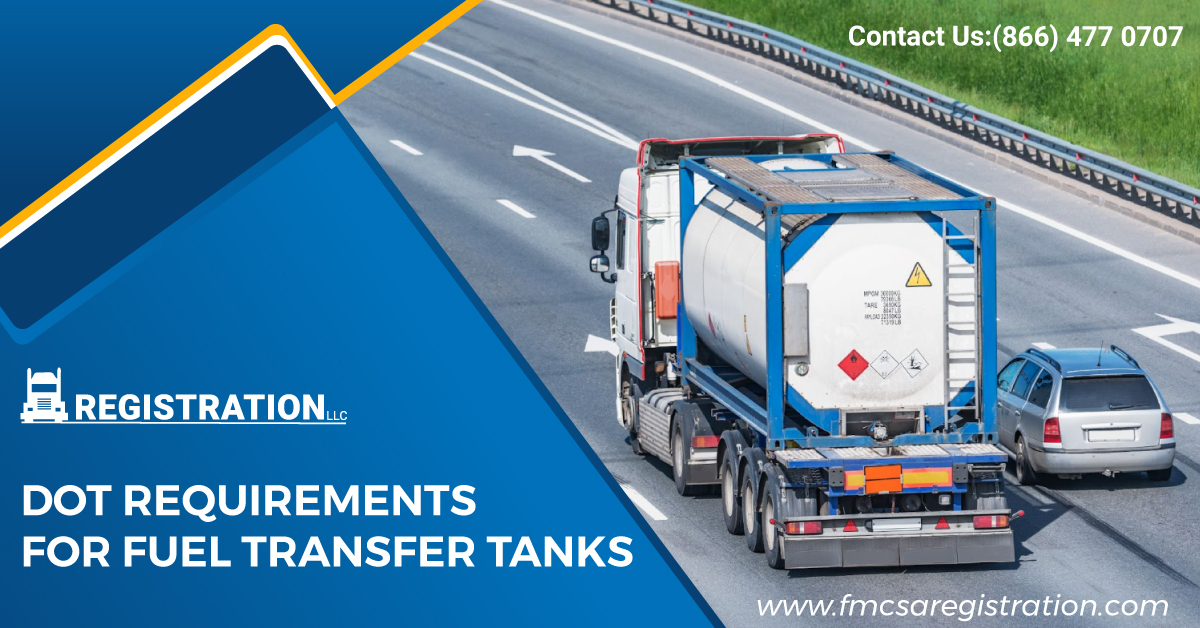
DOT Requirements for Fuel Transfer Tanks and Regulations Overview
Here are some of the most essential DOT requirements for fuel transfer tanks:
- Transfer tanks must be constructed with materials that are compatible with the fuel being stored and handled. Read here about Starting a Trucking Company Correctly.
- All transfer tanks must have a label indicating the type of product being stored.
- A pressure relief device or other safety feature must be installed to protect against overpressure or vacuum conditions. Must visit the link.
- The tank must have a secure closure system, such as a locking cap or lid, and any piping connection should be equipped with a shutoff valve.
- All fuel transfer tanks must meet applicable fire codes and regulations, including proper ventilation systems.
- Diking or other appropriate containment measures should contain any potentially hazardous material spills. What is the DOT SAP Program?
What Is a DOT Approved Fuel Tank?
A DOT-approved fuel tank is a fuel tank that has been certified by the Department of Transportation (DOT) to meet certain design and performance requirements. These tanks are constructed from materials that are highly resistant to corrosion, leakage, and impact damage, ensuring the safe transport of hazardous fuels such as:
- diesel
- gasoline
- kerosene
- aviation fuel
They are designed to provide adequate capacity while also meeting strict fire safety standards. Additionally, they must comply with all applicable federal regulations to be considered approved for use on public roads. Additionally, DOT-approved fuel tanks are often equipped with devices such as gauges and sensors that help monitor levels and ensure the tank doesn't become overfilled or under-pressurized during transport. How To Request the DOT PIN Number?
Please Read Federal Highway Administration, DOT Regulation § 393.67
Our third-party organization encourages you to read Federal Highway Administration, DOT Regulation $ 393.67 to learn the specifics of DOT requirements for fuel transfer tanks. The document features crucial information about FMCSA and DOT regulations related to fuel transfer tanks.
Diesel Fuel Tank DOT Requirements
The Federal Motor Carrier Safety Administration of the US Department of Transportation (DOT) has specific regulations in place for diesel fuel tanks. These standards, outlined in parts 393.67, 571.301, and 393.65, ensure that fuel tanks meet specific structural requirements and proper mounting, testing, and marking. Following these guidelines helps protect both drivers and passengers on the road by reducing the risk of an incident involving a faulty fuel tank. Keeping up with regular inspections to make sure your fuel tank is compliant ensures everyone's safety while on the road. How To Request the DOT PIN Number?
Fuel Tank Regulations for Commercial Vehicles
Per Federal Motor Carrier Safety Administration regulations (Part 393.67), all fuel tanks, including diesel and auxiliary tanks, on commercial vehicles must comply with specific construction standards for:
- joints
- fittings
- pipes
- drains
- overfill protection
- venting
Also, these tanks must be tested to ensure they don't leak or have improper venting. Side-mounted tanks also require additional impact testing to confirm their integrity further. Finally, all commercial vehicle diesel tanks must include the manufacturer’s name and location for identification purposes. All of this is critical for safety on the roads! What is MC Number?
Non-Commercial Vehicle Fuel Tank Regulations
Fuel tanks on non-commercial vehicles weighing 10,000 pounds or less must meet the standards for fuel system integrity set by the FMCSA. School buses are covered under this regulation, too. According to Part 571.301, fuel systems in these vehicles must withstand front-impact crashes, rollovers, rear-end collisions, and side-impact collisions without any significant leakage or spillage. The regulation specifies how much fuel may be spilled during each type of impact and how suitable tests can be performed on the tanks. Visit the DOT Authority Package, which contains tips to prepare for 2022 DOT Week filings in minutes. How do you get an Oregon Trip And Fuel Permit?
Fuel Tank Regulations for All Vehicles
To ensure the safety of all drivers, fuel systems for motor vehicles must meet the requirements outlined in Part 393.65 of the FMCSA regulations. This includes mounting the fuel tank behind the front axle and away from any exhausts, so spilled fuel does not cause a hazard. The fill pipes must be located outside the vehicle for easy access. Furthermore, fuel lines should be installed in a manner that does not hinder towing or compromise the passenger compartment on buses. They must be secured in an area protected from damage or tampering. Must visit FMCSA Hours of Service Suspended topics.
Summary: Key DOT Fuel Transfer Tank Requirements
- Tanks must have a capacity between 25 and 50 gallons (or larger, depending on the tank type).
- Tanks must be made of corrosion-resistant materials, such as steel or aluminum.
- All tanks must have an approved safety system, including a shutoff valve, to prevent overfill and overflow. Also, visit the link.
- All tanks must be labeled with the manufacturer's name, address, and serial number.
- Tanks must be UL 142 listed and meet current DOT standards for construction and use—the importance of The FMCSA 30-Minute Break Rule.
- Ventilation systems are required to ensure that fumes are not trapped inside the tank.
- The fuel transfer tank must be securely mounted in an upright position at all times during operation. Also, take a look at the Drug and Alcohol Program policy. What is DOT Clearinghouse Enforcement? Give us a call.